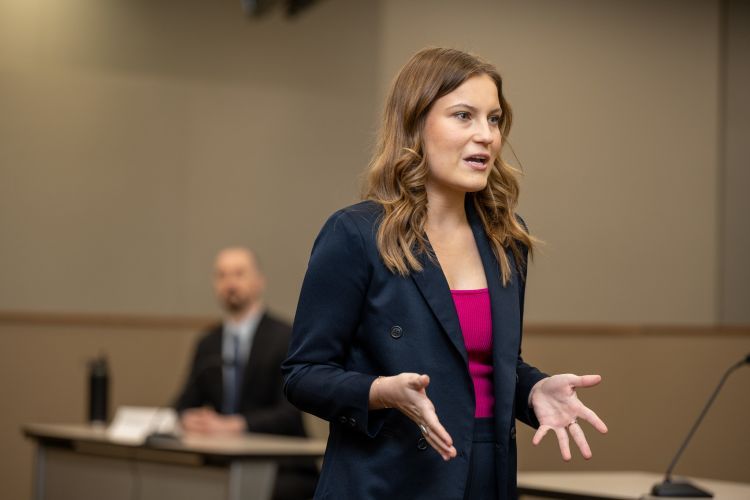Leading Techniques for Creating Impactful Trial Presentations in Courtroom Settings
Navigating the Intricacies of Test Presentations: Tips for Seamless Shipment and Engaging Disagreements
In the realm of legal procedures, the art of test discussion stands as an essential determinant of success. The complexities inherent in trial presentations require a delicate balance of method, ability, and finesse.

Recognizing Test Purposes
To effectively navigate a trial, it is vital to have a clear understanding of the purposes that require to be achieved. Before entering the court, legal teams need to specify their objectives and preferred end results. These purposes offer as leading concepts throughout the test, forming approaches and affecting decision-making procedures.
Recognizing test purposes entails a thorough evaluation of the situation, lawful precedents, and the client's finest interests. Trial Presentations. It requires a precise evaluation of the facts, identifying key issues, and preparing for possible obstacles. By establishing measurable and details objectives, lawyers can tailor their discussions and disagreements to line up with the desired outcomes
Additionally, a clear understanding of trial purposes makes it possible for legal teams to focus on proof, witnesses, and legal debates properly. It enables for the development of a systematic story that resonates with the court and jury, strengthening the total situation presentation.

Organizing Evidence Successfully
Having a clear understanding of trial purposes lays the structure for organizing evidence properly in lawful procedures - Trial Presentations. By aligning the discussion of evidence with the desired end results of the test, legal groups can enhance their arguments and enhance their persuasiveness. One critical element of organizing proof is categorization. Organizing evidence based upon motifs or relevance to specific lawful elements can assist enhance the discussion and make intricate information a lot more absorbable for the judge or jury.
An additional key component in organizing proof efficiently is developing a logical circulation. Presenting evidence in a systematic and sequential way can aid build a compelling story that supports the legal debates being made. Additionally, utilizing aesthetic aids such as graphs, timelines, or graphes can even more boost the company of evidence and help in making clear intricate relationships or sequences of occasions.
In addition, guaranteeing that all evidence offered is appropriate and permissible to the instance is important. Inadmissible or unnecessary evidence can diminish the strength of the disagreement and possibly hurt the reputation of today party. A thorough testimonial and option procedure need to be taken on to consist of just the most impactful and legitimately audio evidence in the anchor trial discussion.
Crafting Influential Stories
Crafting engaging narratives plays a pivotal function in presenting influential arguments throughout legal process. When building a story look at this web-site for a trial discussion, it is important to develop a clear storyline that highlights vital points and attaches them in a coherent manner. By weaving together evidence, testament, and lawful disagreements into a influential and natural story, legal specialists can efficiently support for their clients and boost the likelihood of a positive end result in the courtroom.
Grasping Aesthetic Aids
Efficient usage of aesthetic aids is crucial to boosting the impact and clearness of test discussions. Aesthetic aids, when used purposefully, have the power to streamline complex information, strengthen vital factors, and leave a long lasting perception on the discretionary. To understand visual aids in trial presentations, it is vital to ensure that they are clear, concise, and relevant to the disagreements being made.
When integrating aesthetic help, such as graphes, photographs, timelines, or graphs, into a test discussion, it is important to keep them visually appealing yet professional. The visuals should complement the verbal arguments, providing a visual depiction of the details being reviewed without frustrating the target market with unneeded information.
Additionally, exercising with the visual aids beforehand is important to guarantee a seamless delivery throughout the test. Familiarizing oneself with the content, transitions, and timings of each aesthetic help can assist maintain the flow of the discussion and stop technological glitches that might emerge.
Providing Impactful Closing Disagreements
A compelling closing debate serves as the end result of a trial discussion, encapsulating the core narrative and encouraging the judge and court towards a positive choice. Begin by describing the major arguments that sustain your customer's position, highlighting why the proof presented throughout the test sustains your narrative.
In addition, incorporating emotional appeal can further strengthen your closing argument. Eventually, a well-crafted closing disagreement must leave an enduring impact, engaging the court and court to rule in your customer's support.
Verdict
Finally, understanding test discussions entails recognizing purposes, arranging evidence, crafting narratives, utilizing visual aids, and supplying impactful closing debates. By applying these approaches properly, legal representatives can provide their situation perfectly and make compelling arguments in the court room. It is critical to browse the complexities of test discussions with precision and ability to accomplish success in legal proceedings.
By aligning the discussion of evidence with the desired results of the test, lawful teams can reinforce their debates and improve their persuasiveness (Trial Presentations). To understand visual aids in test discussions, it is important to make certain that they are clear, succinct, and appropriate to the arguments being made
An engaging closing disagreement serves as the end result of a test presentation, enveloping the core narrative and encouraging the judge and jury in the direction of have a peek here a beneficial choice. Begin by detailing the main debates that support your customer's setting, emphasizing why the proof presented throughout the test supports your story.In conclusion, grasping trial discussions involves comprehending objectives, arranging evidence, crafting narratives, making use of visual help, and delivering impactful closing debates.